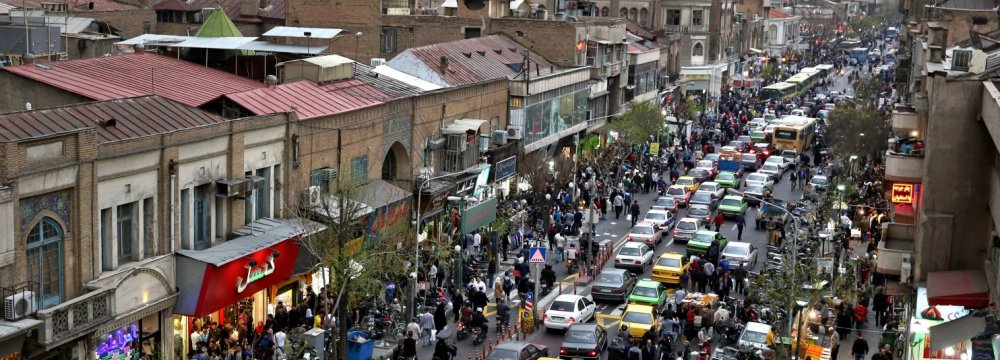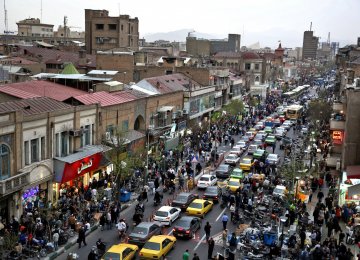Due to its political, economic, educational and other advantages, Tehran has always attracted Iranians from other provinces.
Migration to the capital city to work, study, or live temporarily or permanently has been a common phenomenon over the years, which led to the city’s population growth and a series of environmental issues in the process.
However, statistics show reverse migration, i.e. from Tehran to other provinces, has gained momentum in recent years, Financial Tribune’s sister publication, the Persian economic weekly Tejarat-e Farda, reported.
Experts have linked the current trend to Tehran’s many intractable challenges, including pollution, traffic and the lurking fear of earthquake.
According to the Statistical Center of Iran, findings of the National Population and Housing Census in the last Iranian year (March 2016-17) show a total of 350,632 people migrated from Tehran to other provinces between 2011-12 and 2016-17 fiscal years.
The provinces of Alborz, Gilan, and Mazandaran were the top destinations for migrants from Tehran.
This is while 516,922 people migrated to Tehran during the same period. A majority of the migrants came from Alborz, Lorestan, Hamedan and Khorasan Razavi provinces.
Tehran’s population density is 969 per square kilometer, which is 20 times higher than the national average. With a population of about 8.69 million people (up from 8.15 million registered in the previous census conducted in 2011-12), the capital city has an over 16.5% share in Iran’s total population.
The city is home to 41.9% of the country’s urban population, according to the latest census.
Reasons to Leave
According to the report, although the number of people coming to Tehran surpassed those who leave the city during the period under review, reverse migration is seemingly on the rise amid growing environmental problems and saturation of opportunities there.
In fact, air pollution, road traffic and fear of earthquake have been cited as the main reasons for people wanting to leave Tehran.
A paper submitted to the International Conference on Urban Economy held in 2016 by Iran Urban Economics Scientific Association suggests the population of Tehran has long surpassed its optimal size.
It indicated that more than 70% of Tehran’s population have exceeded the optimum level. In other words, Tehran can only provide 2.38 million of its citizens with favorable living conditions.
Moreover, a study by UK-based Zipjet Company ranked Tehran as the sixth most stressful city among 150 cities surveyed in relation to traffic levels, public transport, green spaces, financial status of residents, including debt levels, physical and mental health.
In the factors assessed by Zipjet, Tehran received a score of 8.67 in population density, 9.21 in green spaces (percentage of public green spaces inside the city limits), 6.62 in satisfaction with public transport, 8.55 in traffic congestion levels, 9.4 in perception of security (weighted average rate of theft and murders), 8.25 in annual mean air pollution, 4.5 in noise pollution and 6.98 in light pollution.
Tehran scored 8.55 in unemployment rate, 7.52 in debt per capita, 1.30 in social security, 7.77 in family purchasing power, 6.07 in mental health, 7.95 in physical health, 9.76 in gender equality and 9.1 in race equality.
A low score indicates a low level of stress, with each increasing number indicating a higher level of stress for the factor. A score of 1 represents the least amount of stress possible and 10 indicates the most.
Inflow Outpacing Outflow
The growing number of educated as well as jobless people coming to Tehran in the hope of finding work is overcrowding the capital city, although the city lacks proper infrastructure to host the rising influx of people.
The findings of the latest census show population growth in Tehran is mainly driven by a large influx of migrants, rather than a natural increase in population, i.e. the difference between the birthrate and death rate.
Tehran’s migrant population has increased to 20.2% of the country’s total number of immigrants from 17.7% in the fiscal 2011-12.
According to the Ministry of Roads and Urban Development, migrants have constituted as much as 88% of the rise in Tehran’s population (1.08 million) over the past five years. Migrant population saw a 15% decline in the country to stand at 4.7 million from 5.53 million five years ago.
However, the rate of migrant population decline in Tehran was about 3% over the past five years. This has led to an 8% rise in population of Tehran compared to the average 6% population growth in the country.
The report concluded that the growing trend of reverse migration from Tehran should be considered as a good omen and an opportunity to address the host of problems exacerbating living conditions in the capital city.






Add new comment
Read our comment policy before posting your viewpoints